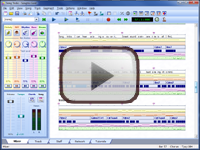(5.10) Straight and Swing Timing
Two terms you may sometimes comes across, particularly in rock, blues or jazz are straight timing and swing timing. Most music can be played either way, and will sound like the same piece, but with a very different feel.
Straight timing is where the beat is split into equal subdivisions (a ratio of 1:1) for playing notes. Swing timing is where the beat is split into two-third plus one-third subdivisions (a ratio of 2:1).
The difference can be well demonstrated with a rock'n'roll style rhythm that would typically be played on the lower two strings of a guitar.

Both alternatives sound very similar to each other, and yet distinctly different. The straight version has more of a driving regular rhythm, while the swing version, even at the same tempo, has a more laid back, cruisy feel.
The straight version can be notated relatively easily in simple eighth-notes as follows:

The swing version, on the other hand, presents problems. You will sometimes see this type of rhythm notated using dotted eighth-notes and sixteenth-notes, as shown below.
This seems convenient, but it is incorrect, and should be avoided. Listen carefully to how this notation actually sounds and you will hear it is not the same as swing timing.

It sounds jerky and stilted, not at all the smooth rolling rhythm that we should get with swing timing. Remember that we need a 2:1 ratio of beat subdivisions, whereas this notation has a 3:1 ratio (dotted eighth-note = 1/8 + 1/16 = 3/16, sixteenth-note = 1/16).
To write swing notation correctly, we need to use (as you might have guessed) triplet signs. The following passage is now faithful to the true timing ratios in swing.

It looks untidy, though. Every note length needs to be adjusted with triplet signs, which will be scattered throughout our notation, making it tedious to write and messy to read.
There is a better solution which gives the correct timing, while also being simpler to notate. All that is required is that we change time signatures.
Remember the compound time signatures (6/8, 9/8 and 12/8) we looked at a couple of topics ago? This is exactly what they are designed for - to simplify notation when the main beat has been split into triplets. The following conversions are typical:



Our swing rhythm notation can be converted as follows:

Notice that the tempo has also been adjusted as a direct result of the meter change. Since we are now fitting a quarter- plus an eighth-note into the space of what used to be a quarter-note, the length has been increased by 50%. So the tempo also needs to increase by 50% to 180 qpm, to retain the same overall speed of play.

ChordWizard products such as Songtrix offer a powerful and convenient function which allows you to convert the meter of a song in this way. The notation in Staff View is updated automatically.
|
Topic 69 of 117
| ||
Bring these music concepts to life with the free Songtrix Bronze Edition as you create songs from chords and scales.
Then publish and share your ideas with the other musicians you meet on the ChordWizard Network.
Have questions? Join the ChordWizard Network and post them in the Music Theory forum for answers and discussions on your topics of interest.








